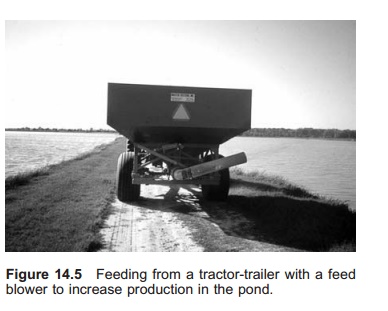Chapter: Aquaculture Engineering : Ponds
Pond types
Pond types
There are several ways to classify ponds: one is based on construction and another on whether it is possible to drain the pond or not.
Construction principles
Based on their construction three types of ponds can be identified: watershed, excavated and embankment or levee ponds (Fig. 14.3). Watershed ponds utilize the terrain features; for instance, a ravine can be dammed so the construction is quite simple. However, there are few sites that satisfy the requirements for a watershed pond, so this is not a very common pond type. An excavated pond is simply a hole in the ground which is filled with water. Part can be below the water table and in this way water infiltrates into the pond, but this construction is little used.

The main type of construction is the embankment or levee pond. There are several ways to establish such ponds: they can be at ground level, or the levee can be above and the bottom below ground level. For the first type it is necessary to supply material; for the second type the excavated material can be used to construct the leveess which will reduce the cost of establishing the pond. Levee
When constructing the pond it is an advantage to ensure that it is possible to tap the water to a lower level to make drainage possible. Eventually a canal drainage system can be excavated in conjunction with the pond area.
Drainable or non-drainable
Depending on the construction of the outlet system, traditional earth ponds can be divided into drainable and non-drainable ponds (Fig. 14.4); non-drainable ponds are normally larger, up to several hectares. Small natural lakes used for aquaculture production function like a non-drainable pond. The same is the case if a ravine is dammed, watershed ponds are used or if a hole is excavated in the ground. Low establishment cost is the main advantage with non-drainable ponds. Natural lakes can also be used and create a low cost farming volume.

The advantage with drainable ponds is the possibility for a more effective harvesting process and to have control over the water level, because the water can be drained out of the pond. It is simpler to fertilize/feed, and also to supply additional air. While non-drainable ponds are normally run extensively, drainable ponds can be run more intensively, depending on the amount and growth rate of the fish. In intensive drifted ponds the fish can be fed (Fig. 14.5), and additional air supplied periodically.
This may also be done without damaging the ecosystem in the pond, if extra care is taken. In ponds the production is given in kg per hectare of pond surface area. This varies with water temperature, environmental conditions, pond type and the fish species, so it is difficult to give a general value. A rough estimate is 1000 kg/ha, but this can vary by a factor of 10 in both directions: over 15 000 kg/ha can be achieved for channel catfish by use of additional feeding and continuous aeration.

Related Topics